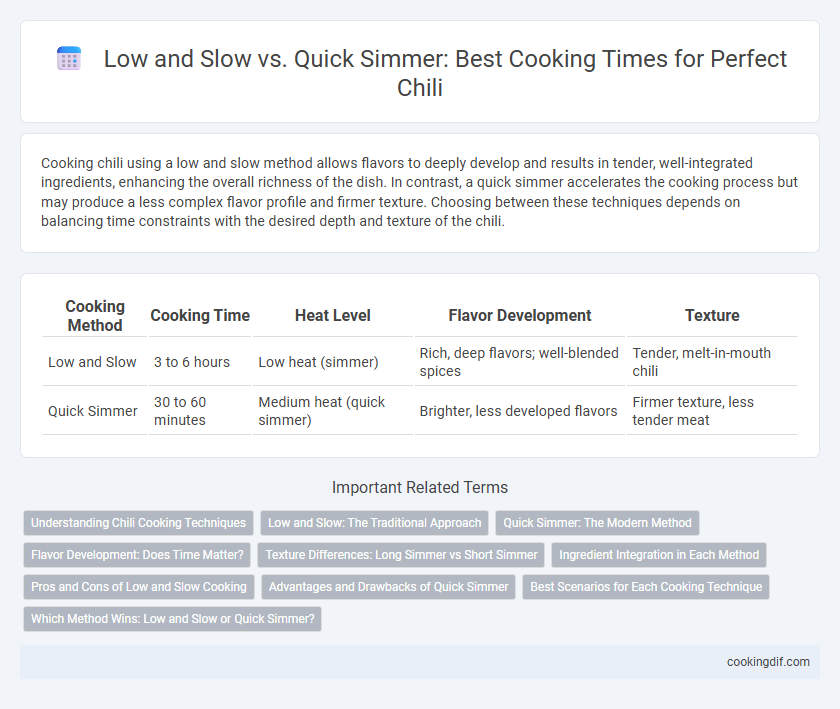Cooking chili using a low and slow method allows flavors to deeply develop and results in tender, well-integrated ingredients, enhancing the overall richness of the dish. In contrast, a quick simmer accelerates the cooking process but may produce a less complex flavor profile and firmer texture. Choosing between these techniques depends on balancing time constraints with the desired depth and texture of the chili.
Table of Comparison
| Cooking Method | Cooking Time | Heat Level | Flavor Development | Texture |
|---|---|---|---|---|
| Low and Slow | 3 to 6 hours | Low heat (simmer) | Rich, deep flavors; well-blended spices | Tender, melt-in-mouth chili |
| Quick Simmer | 30 to 60 minutes | Medium heat (quick simmer) | Brighter, less developed flavors | Firmer texture, less tender meat |
Understanding Chili Cooking Techniques
Low and slow cooking techniques for chili enhance the development of deep, rich flavors by allowing tough cuts of meat to tenderize fully, typically requiring several hours of simmering at a low temperature. Quick simmer methods reduce cooking time significantly but may result in a less complex taste and firmer meat texture, ideal for weeknight meals. Mastering these techniques improves the balance between flavor extraction and texture, crucial for achieving a well-rounded chili.
Low and Slow: The Traditional Approach
Low and slow cooking preserves the rich flavors and tenderizes tough cuts of meat in chili, allowing spices to meld deeply over several hours. This traditional approach promotes a robust, well-balanced taste that quick simmering cannot replicate due to its shorter cooking time. Slow simmering also enhances texture, resulting in a hearty and satisfying chili experience prized by enthusiasts.
Quick Simmer: The Modern Method
Quick simmer is a modern method for cooking chili that significantly reduces cooking time while maintaining robust flavor development through rapid heat application. This technique uses controlled medium heat to bring the chili to a rapid bubbling point, preserving the texture of vegetables and meat without breaking down ingredients excessively. By minimizing cook time to about 30-45 minutes, quick simmer retains the chili's vibrant taste and appealing consistency, ideal for busy cooks seeking efficiency without sacrificing quality.
Flavor Development: Does Time Matter?
Low and slow cooking allows chili to develop complex, rich flavors as the extended simmering time breaks down tough meat fibers and blends spices thoroughly, enhancing depth and tenderness. Quick simmering speeds up the process but often results in a less intense flavor profile and slightly tougher textures due to insufficient time for full ingredient integration. Time is crucial in chili flavor development, with longer cooking contributing significantly to the dish's signature richness and balance.
Texture Differences: Long Simmer vs Short Simmer
Low and slow simmering in chili cooking results in tender, well-integrated textures as collagen breaks down and flavors meld over time. Quick simmering retains firmer meat and distinct ingredient textures, offering a chunkier, more pronounced bite. Extended cooking softens beans and vegetables, creating a creamy, cohesive consistency, while a short simmer preserves individual component firmness and freshness.
Ingredient Integration in Each Method
Low and slow cooking allows chili ingredients like beans, meat, and spices to fully meld, enhancing depth and complexity of flavors through gradual heat exposure. Quick simmering can keep ingredients distinct, preserving their individual textures but often limiting the full integration of spices and seasoning. Ingredient integration in low and slow chili results in a richer, more cohesive dish compared to the sharper, separated flavors typical of quick simmer.
Pros and Cons of Low and Slow Cooking
Low and slow cooking chili allows flavors to meld deeply, resulting in tender meat and a rich, well-developed taste profile. This method requires extended cooking times, often several hours, which can be impractical for quick meals and may risk overcooking if not monitored carefully. However, the enhanced depth of flavor and texture achieved through slow simmering often outweighs the time investment, making it ideal for traditional chili recipes.
Advantages and Drawbacks of Quick Simmer
Quick simmer cooking in chili reduces overall preparation time by sealing flavors rapidly, preserving fresh ingredient textures and vibrant colors. However, this method risks uneven flavor development and tougher meat due to insufficient collagen breakdown compared to low and slow cooking. Optimal results may require closer monitoring to prevent burning or scorching during the faster simmer process.
Best Scenarios for Each Cooking Technique
Low and slow cooking is ideal for chili recipes with tough cuts of meat or dried beans, allowing flavors to deeply meld and textures to tenderize over several hours. Quick simmering suits dishes requiring faster preparation, such as chili with ground beef or canned beans, enhancing vibrant spice profiles without overcooking. Choosing between these techniques depends on desired texture, ingredient type, and optimal flavor extraction for authentic chili experiences.
Which Method Wins: Low and Slow or Quick Simmer?
Low and slow cooking allows chili flavors to meld deeply, tenderizing tough cuts of meat and developing complex, rich aromas over several hours. Quick simmer methods can produce a decent chili in under an hour but often sacrifice depth and tenderness, resulting in a less vibrant taste profile. For a hearty, full-bodied chili experience, low and slow consistently delivers superior results compared to quick simmering.
Low and Slow vs Quick Simmer for cooking time Infographic

 cookingdif.com
cookingdif.com